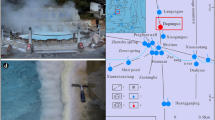Abstract
Natural hot spring waters ascending rapidly to the surface become supersaturated with respect to quartz because of rapid cooling, separation of steam and sluggish deposition of quartz and other crystallineSiO 2 phases. Large amounts of silica are likely to be deposited in hot spring systems only after the solubility of amorphous silica has been exceeded. Cristobalite and chaleedony probably form in hot spring systems only by the crystallization of previously deposited silica gel rather than by direct deposition from solution.
Experimental data indicate that the solubilit of quartz in water rises with increasing temperature along the vapor pressure curve to a maximum value of 725 ppm at 330°C. However, the maximum amount of silica likely, to occur in hot spring systems where quartz precipitates at depth is appreciably greater. Steam formation during adiabatic cooling of a water quickly brought to the surface from 330°C at depth might leave the silica in the remaining liquid concentrated to about 1150 to 1400 ppm. Under such conditions, amorphous silica might precipitate (probably as a colloidal suspension) after the water cooled below about 200°C to 250°C. Waters initially in equilibrium with quartz at a temperature less than 210°C probably will precipitate amorphous silica in channelways underground only when and where large quantities of steam separate from the waters as a result of sudden decreases in pressure or hydrostatic head.
Above 150° to 200°C amorphous silica and volcanic glass can contribute very large quantities of silica to the solution. However, at these temperatures in natural systems they are eventually converted to crystalline phases. Thus, control of dissolved silica at depth is likely to be relatively short lived in respect to the ages of most hot spring systems.
The dissolved-silica content of 90 hot spring waters from Yellowstone National Park was measured colorimetrically in the field immediately after collection. Comparison with laboratory studies on the solubility of amorphous silica indicates that many waters in «alkaline» springs are markedly undersaturated with silica with respect to amorphous silica at the temperatures of the pools. Thus, the dissolved silica content of these waters cannot be accounted for by equilibria with amorphous silica. Rather, silica appears to be controlled by the dissolution, deposition, or alteration of other silica-bearing phases at depth. Furthermore, many springs now have compositions essentially identical (with respect to all components) to those determined in 1888, indicating that either equilibrium or steady state conditions have prevailed at depth for a long time. Veins of fine-grained quartz were found in drill core from the Upper Basin, and it is reasonable to assume that quartz controlled the quantity of silica in solution in those places of deposition. Possibly the silica content of the surface waters might allow an estimate of the temperatures at which these waters were last in equilibrium with quartz at depth.
Assuming adiabatic cooling along the vapor pressure curve and correcting for steam formation, quartz solubility data compared with natural water analyses suggests that underground temperatures approach 205°C in the Upper Geyser Basin of Yellowstone. In the Norris Geyser Basin, underground temperatures of 245°C are suggested.
Similar content being viewed by others
Additional information
Publication authorized by the Director, U.S. Gological Survey.
Paper read at the IAV International Symposium on Volcanology (New Zealand), scientific session of Nov. 30, 1965.
Rights and permissions
About this article
Cite this article
Fournier, R.O., Rowe, J.J. The deposition of silica in hot springs. Bull Volcanol 29, 585–587 (1966). https://doi.org/10.1007/BF02597179
Issue Date:
DOI: https://doi.org/10.1007/BF02597179




